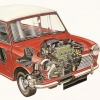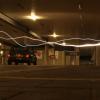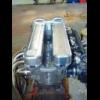
First Time Brake Bleeder
#1

Posted 11 February 2011 - 03:10 PM
Year: 79
Description of problem (please be as in depth as possible):
Okay so I'm about to bleed all my drum brakes. Never done this before. I've been doing a lot of reading via Google and this very forum and I have a vague idea what to do.
Spare tyre about 10psi.
Fill Eezibleed bottle with fresh brake fluid
Connect Eezibleed to tyre and brake fluid reservoir using correct size cap. Make sure not to over-tighten as I could break a seal
Unscrew bleed nipple and bleed in correct order; one at a time
My questions are:
Which circuit do I have for my year?
How do I know when each drum is completely bled? I'm assuming when no liquid comes out.
Will the reservoir contents completely be replaced with new liquid at the end?
I bought a litre of DOT4 from Halfords. I know these threads have come up many times before and the replies have given me some confidence in doing it. I'd just like to make sure I'm doing it all correctly and don't waste liquid/money.
#2

Posted 11 February 2011 - 03:17 PM
Check first pressure test with just air and go over all the pipes, as mine had a tiny hole in one pipe and squirted fluid every where!! kit had never been used but most likely from
how its rammed in a box with the pipe bent over.
I think if you want it completely new fluid you first connect it all up not filling the bottle with fluid then open nipple, this dispels all old fluid, then take off bottle and
fill and bleed!
Also I would imagine need more than 10psi, mine started of 20 psi as it says max but that didnt push a great deal through on my clutch and thats a
lot smaller system than brakes.
Wonderful idea as pedal was solid after and I could do it all by myself!
#3

Posted 11 February 2011 - 03:32 PM
Right okay well that seems easy enough, but I think I remember reading not to let the reservoir empty because that can get air in the brske lines; which you don't want. I guess when it's nearly empty I put fresh liquid in the Eezibleed and comtinue?
I did read someone say they've been using 30psi for years, not knowing the kit says 20.
#4

Posted 11 February 2011 - 03:41 PM
Yeah, my tyre pipe has a link in it right near the cap. Annoyingly! I'll test the Eezibleed with air first, then. I take it you just connect the Eezibleed to the tyre but not the other pipe to the brake fluid reservoir, and just feel for air leaks with your finger?
Right okay well that seems easy enough, but I think I remember reading not to let the reservoir empty because that can get air in the brske lines; which you don't want. I guess when it's nearly empty I put fresh liquid in the Eezibleed and comtinue?
I did read someone say they've been using 30psi for years, not knowing the kit says 20.
Mine had a hole right near where the clear pipe goes in top of reservoir bottle, not easy to see at all! wasnt to impressed at having to pay £28 for another kit at a local motor factors no choice
though as cant see it be easy to replace just the pipe! and i needed a clutch!
Ideally connect it all up but not to car then let air through and see if can find a leak!
It did say in the instructions how to do it so you can empty system of fluid first then fill with fresh, I know what you mean if the cap from ezi bleed was not on reservoir then you would be letting air
back in but im sure in the bottle there is a one way or something to stop air going back or something lol!
Next time i will start off with more for sure!
#5

Posted 11 February 2011 - 03:45 PM
#6

Posted 11 February 2011 - 03:47 PM
My questions are:
Which circuit do I have for my year?
How do I know when each drum is completely bled? I'm assuming when no liquid comes out.
Will the reservoir contents completely be replaced with new liquid at the end?
1. doesn't matter
2. wait till clean fluid comes out
3. yes
when i do a full fluid change i bleed through once and then go back again just for a couple of seconds on each just in case
also prefer dot 5.1 fluid
#7

Posted 11 February 2011 - 03:56 PM
The instructions do say to partially drain the reservoir by opening one bleed nipple (in step 3 out of 11) to reducing mixing old fluid with new.
#8

Posted 11 February 2011 - 03:59 PM
assuming you've got metal cylinder you wont be bale to tell how clean it is inside though!!
#9

Posted 11 February 2011 - 04:05 PM
Type 1 master cylinder
Type 2, 3 and 4 tandem master cylinders with diagonal split dual circuit braking systems
Type 2 and 3 tandem madter cylinders with front-to-rear split dual circuit braking systems
Type 4 tandem madter cylinders with front-to-rear split dua circuit braking systems
But I'm inclined to do it NSR, OSR, NSF, OSF.
#10

Posted 11 February 2011 - 04:07 PM
by the way be patient with my replies. Have to use my HTC Hero.
#11

Posted 11 February 2011 - 05:24 PM
#12

Posted 11 February 2011 - 05:57 PM
#13

Posted 11 February 2011 - 10:07 PM
ANON: You say it doesn't matter which circuit I have but Haynes shows bleeding sequences for...
...But I'm inclined to do it NSR, OSR, NSF, OSF.
sorry thought i had said you will have metal/old one.
bleeding sequence is correct
#14

Posted 11 February 2011 - 11:44 PM
1 user(s) are reading this topic
0 members, 1 guests, 0 anonymous users
















